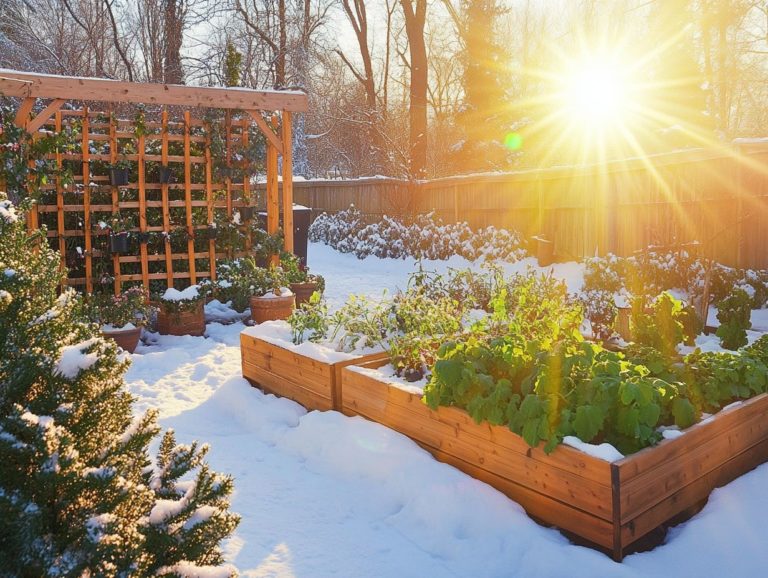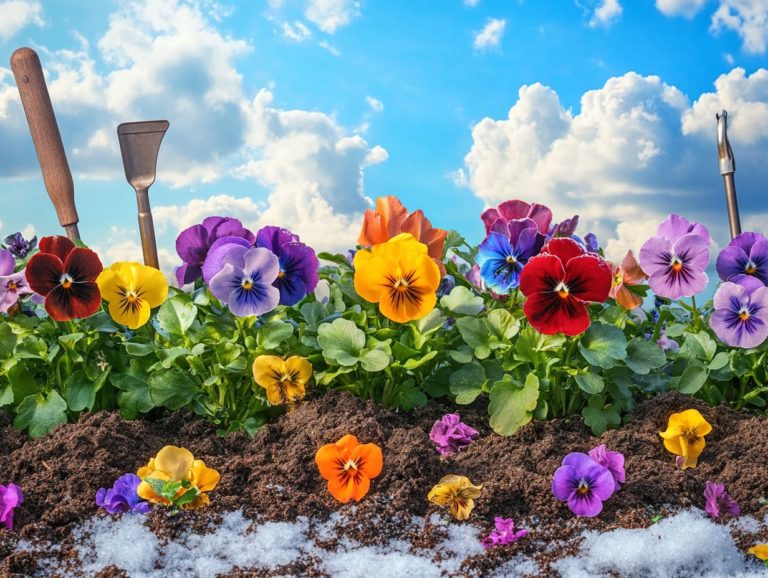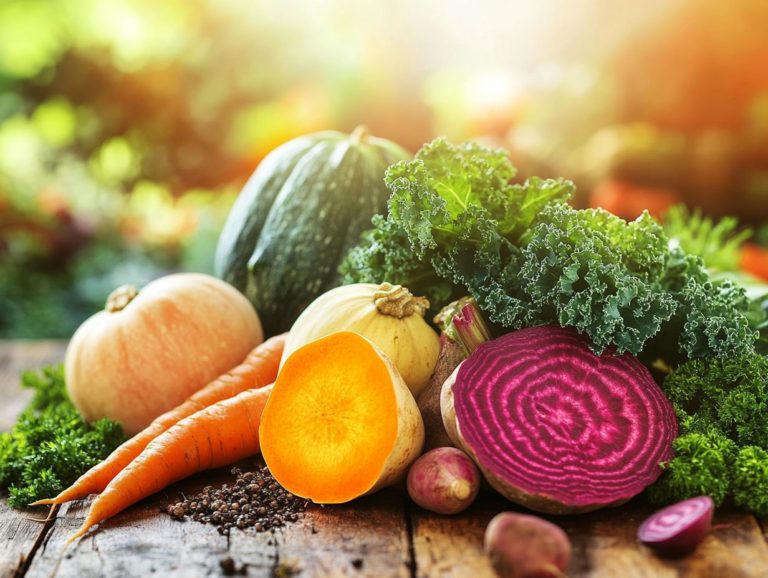Benefits of Winter Gardening for Cold Climates
Winter gardening may initially seem like a challenging task. However, it unveils a realm of opportunities for passionate gardeners, even in the iciest climates.
This article delves into the myriad advantages of cultivating a winter garden. From enhancing your health to fostering environmental sustainability, you ll find insights on essential tools and discover the best plants to nurture during the colder months.
You will also learn how to reap a generous harvest and whip up delectable recipes straight from your winter garden. Embrace the season and unlock the full potential of your outdoor space, no matter the time of year!
Contents
- Key Takeaways:
- Benefits of Winter Gardening
- Preparing for Winter Gardening
- Tips for Successful Winter Gardening
- Harvesting and Enjoying Winter Garden Produce
- Frequently Asked Questions
- What are the benefits of winter gardening for cold climates?
- Can winter gardening in cold climates help save money?
- What types of plants can be grown in a winter garden in a cold climate?
- How does winter gardening benefit the environment in cold climates?
- What are some tips for successful winter gardening in cold climates?
- Are there any additional health benefits of winter gardening in cold climates?
Key Takeaways:
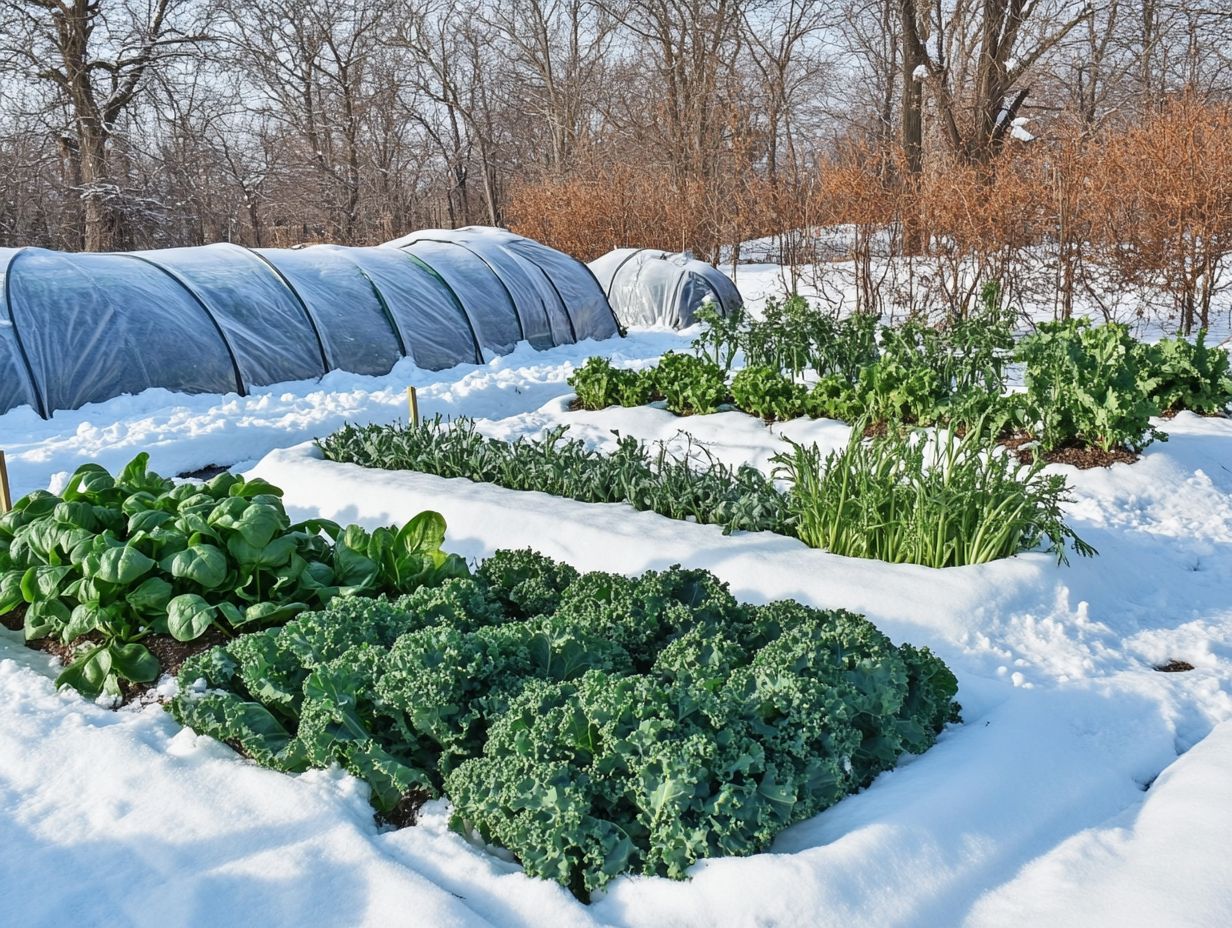
- Winter gardening is a great way to enjoy fresh produce and stay active during the colder months in cold climates.
- Aside from the obvious benefits of having fresh produce, winter gardening can also improve air quality and reduce stress levels.
- With the right preparation and care, winter gardening can be successful with the right tools, plant choices, and techniques.
What is Winter Gardening?
Winter gardening presents an inventive opportunity for you to extend your growing season, even when the temperatures plummet. By employing various techniques like cold frames, row covers, mini hoop houses, and greenhouses you can cultivate a delightful array of vegetables, regardless of the harsh winter conditions.
Grasping the principles of organic gardening and familiarizing yourself with hardiness zones the climate zones that determine which plants can survive in your area can markedly enhance your success, ensuring a steady supply of produce throughout the year.
These methods shield your plants from frost while promoting sustainable practices. For example, cold frames effectively trap solar energy, creating a cozy microclimate that s ideal for tender greens and root vegetables such as spinach, kale, and carrots.
Mini hoop houses, with their adaptable design, allow you to cover larger areas, encouraging a diverse crop yield even as temperatures drop. Selecting the right crops is critical; understanding which vegetables flourish in specific hardiness zones will give you the power to plan effectively.
Crops like garlic and shallots are perfect companions for winter, while robust greens like Swiss chard and winter radishes can endure the chill, promising a vibrant harvest for those determined to persevere through the season.
Benefits of Winter Gardening
Winter gardening presents a wealth of benefits that extend far beyond merely prolonging the growing season. It enables you to savor fresh produce even in the chillier months while enhancing soil health and fostering greater biodiversity in your garden. For more insights, check out these tips for sustainable winter gardening.
This seasonal endeavor offers a unique chance to immerse yourself in your passion throughout the year. Much like Rick Stone of Our Stoney Acres in Utah, who cultivates a sustainable and resilient gardening practice, take this chance to transform your gardening experience and enjoy the fruits of your labor all winter long.
Why Garden in the Winter?
Gardening in the winter offers you unique opportunities to savor fresh produce all year long, as illustrated by Rick Stone at Our Stoney Acres. Choosing cold-climate gardening not only enables you to harvest nutritious vegetables but also deepens your connection with nature during the chilly months.
By engaging in this practice, you can maximize your use of space and resources, contributing positively to food sustainability and environmental mindfulness. This approach allows you to grow crops like kale, spinach, and carrots, which thrive in the cold.
It also instills a sense of purpose and accomplishment during a season often seen as dormant. By employing techniques such as cold frames and row covers, you can transform what might be a bleak landscape into a vibrant, fruitful haven.
For those who embrace this endeavor, the thrill of harvesting fresh greens even in January adds an exhilarating dimension to the gardening experience. It reinforces your commitment to sustainable living while enjoying the rewards of your hard work.
Start your winter garden today and enjoy the rewards of your hard work!
Environmental and Health Benefits
Engaging in winter gardening not only gives you access to fresh produce but also offers remarkable environmental and health benefits that support a sustainable lifestyle. By employing organic gardening techniques and understanding the benefits of using compost in cold climates, you can enhance soil health and promote biodiversity within your local ecosystems.
Enjoying fresh, home-grown vegetables during the winter months can lead to improved health outcomes and a more nutritious diet, highlighting the benefits of growing root vegetables in winter and the holistic advantages of winter gardening.
Such practices enrich the soil by boosting healthy bacteria in the soil, with research indicating that organic matter can improve soil structure and nutrient retention by as much as 90%. The diverse array of winter crops you cultivate serves as habitats for various beneficial insects, playing crucial roles in pollination and natural pest control.
Studies reveal that a vegetable-rich diet can reduce the risk of chronic diseases, with winter staples like kale and carrots supplying essential vitamins A and C, along with fiber that supports overall health. Thus, your winter gardening efforts not only nurture the environment but also foster healthy communities through sustainable food sources.
Preparing for Winter Gardening
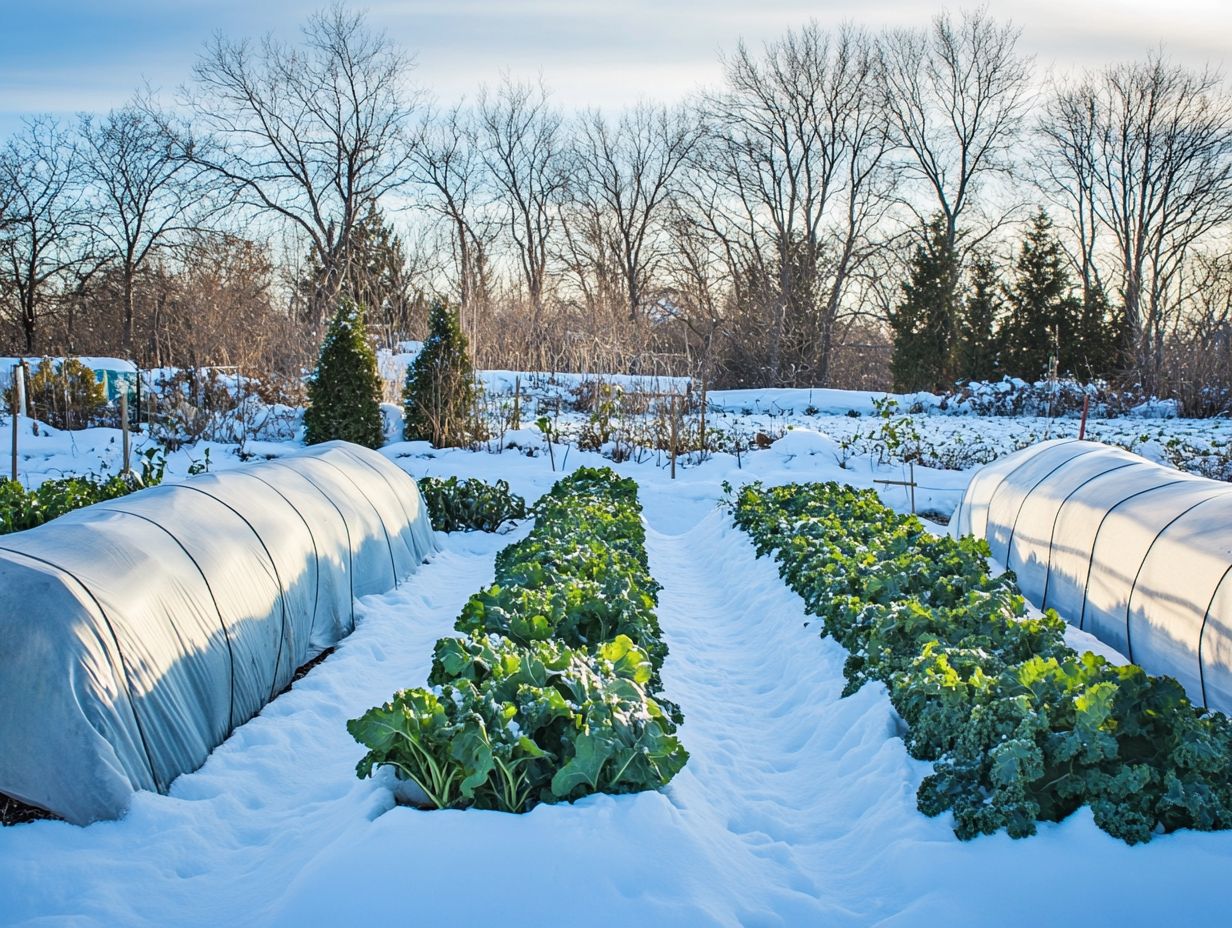
Preparing for winter gardening requires thoughtful planning and a discerning selection of tools and supplies to ensure successful cultivation during the colder months.
Essential instruments like cold frames, row covers, and mini hoop houses are pivotal in safeguarding your crops against the brutal winter elements.
Understanding crop selection based on hardiness zones is crucial for your winter garden’s success, giving you the power to flourish even in challenging climates.
Essential Tools and Supplies
To embark on a successful winter gardening journey, equipping yourself with the right tools and supplies is crucial for safeguarding your plants and maximizing crop yield.
In addition to the basics, consider investing in high-quality garden thermometers to monitor temperature fluctuations. Soil covers that insulate the ground and help retain moisture are also important. These tools shield your garden from harsh winter elements and encourage healthier growth by maintaining optimal soil temperatures. And don t underestimate the power of thermal blankets; they can provide that extra layer of protection on particularly frigid nights.
Local garden stores and online retailers are excellent resources for these supplies, often offering valuable insights on the best products suited to your specific climate.
Choosing the Right Plants
Choosing the right plants for winter gardening is essential for achieving a fruitful harvest, as different crops possess varying levels of hardiness. You’ll find that vegetables like carrots, spinach, kale, Swiss chard, and bok choy thrive in colder temperatures, making them perfect candidates for your winter garden.
By familiarizing yourself with hardiness zones areas defined by climate conditions that indicate which plants can thrive and selecting the right crops, you can cultivate a winter garden rich in fresh produce.
Dive into experimenting with different varieties! This can lead to enhanced flavors and improved yields, fostering your innovative spirit while encouraging you to adapt your practices to the specific climate conditions.
Ultimately, a well-planned winter garden can become a year-round resource, enriching both your kitchen and your gardening journey, especially when you consider the challenges of winter gardening and solutions.
Start planning today to enjoy the fruits of your labor this winter!
Tips for Successful Winter Gardening
Successful winter gardening demands particular strategies and techniques to safeguard your plants from the cold while ensuring optimal growth and yield. By employing effective methods for managing soil health and refining your watering practices, you can cultivate an environment that supports your crops.
Utilizing protective measures such as row covers and cold frames will shield your plants from the harsh winter elements. This approach allows you to maintain an organic garden with ease throughout the season.
Protecting Plants from Cold and Snow
Shield your plants from cold and snow to ensure they stay healthy and productive. By utilizing protective methods like row covers, cold frames, and mini hoop houses, you can effectively shield your plants from frost, snow, and extreme temperatures.
Creating small areas with different climate conditions helps soften the harsh impacts of winter, promoting sustainable growth for your winter crops. Each method serves distinct purposes; for instance, they can trap heat and retain moisture, making them vital for hardy plants like kale, spinach, and chard, which actually thrive in frigid conditions.
- Row covers are lightweight, breathable fabrics that provide insulation while allowing sunlight and water to penetrate.
- Cold frames, on the other hand, are sturdy structures that cradle delicate plants, effectively regulating temperature and protecting them from biting winds.
- Mini hoop houses offer a more robust solution, creating a semi-permanent greenhouse effect that can be invaluable for sustaining your crops through winter’s worst.
By implementing these strategies thoughtfully, you can set yourself up for a flourishing winter harvest.
Managing Soil and Watering
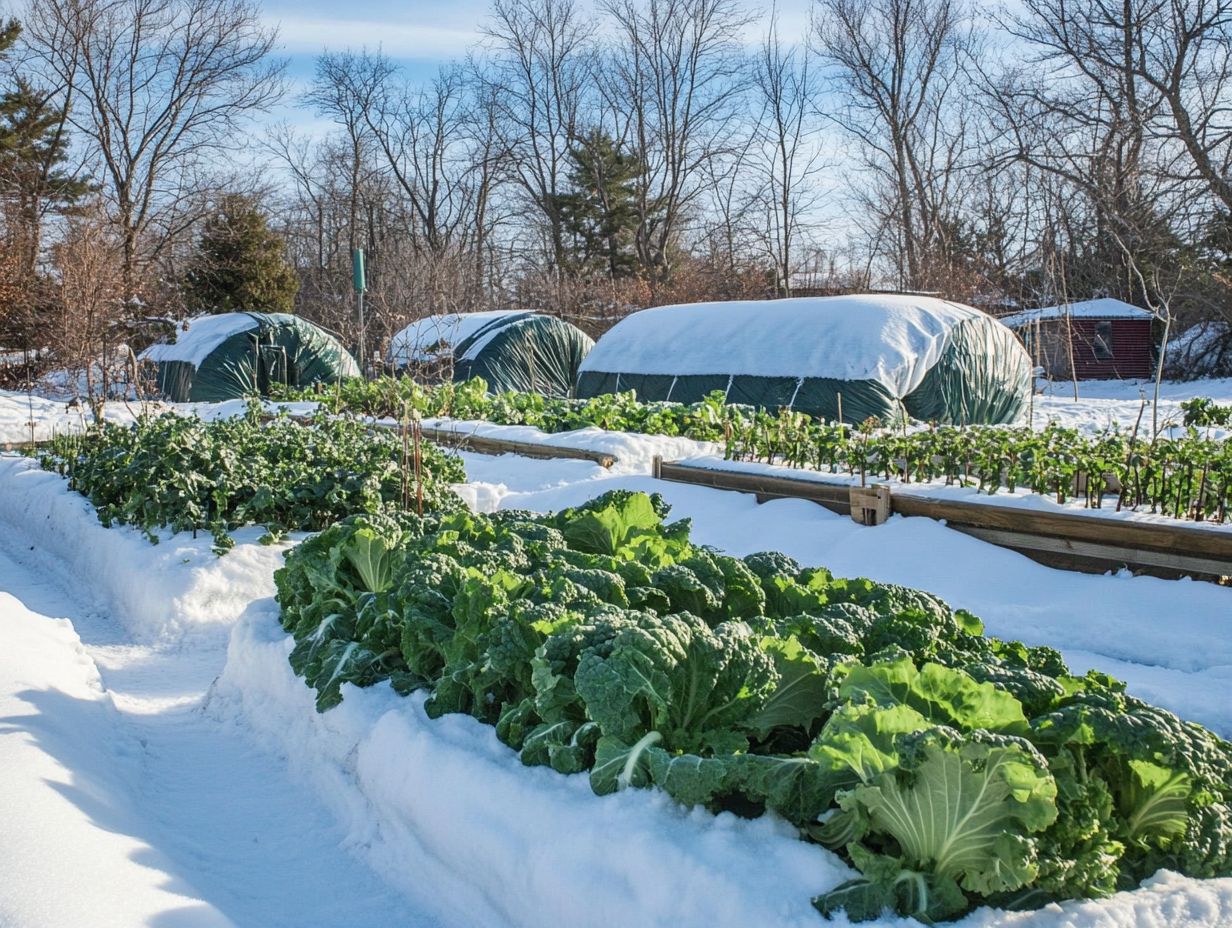
Managing soil and watering is key to a thriving winter garden. Cold temperatures can affect both, so it’s crucial to keep an eye on them.
By incorporating organic matter into your soil, you not only enhance its structure and fertility but also improve its moisture retention crucial for your winter crops. Regularly monitoring and adjusting your watering practices will ensure that your plants receive the hydration they need during the colder months.
To boost soil quality, consider adding amendments like compost, well-rotted manure, or aged leaf mold. These additions provide necessary nutrients and foster beneficial microbial activity.
Mulching around your plants with straw or wood chips can significantly reduce evaporation and stabilize soil temperature. Techniques like cover cropping can further enhance soil fertility while preventing erosion, setting the stage for a robust garden.
By prioritizing these strategies, you can cultivate an environment where your plants not only survive but thrive, even when winter s chill sets in.
Harvesting and Enjoying Winter Garden Produce
Harvesting from your winter garden is one of the most rewarding experiences. Enjoy fresh flavors even in the cold!
By applying the best harvesting practices, you ensure that your vegetables are picked at their peak freshness, which in turn maximizes both flavor and nutritional value.
Exploring a variety of recipes and meal ideas inspires you to use your winter garden’s bounty in delightful ways.
Imagine stepping into your winter garden to harvest fresh, vibrant greens there’s nothing quite like it! Start your winter gardening journey now to experience the joy of growing your own food in the colder months.
Best Practices for Harvesting and Storing
Employing best practices for harvesting and storing winter vegetables is crucial for preserving their quality and flavor. This allows you to enjoy fresh produce long after it has been picked! Techniques like careful handling during harvest and ensuring optimal storage conditions significantly extend the shelf life of your crops, maximizing every yield in your organic gardening endeavor. This approach minimizes waste, letting you savor every bite!
Understanding the right moment to harvest is essential. Pick your vegetables when they are at their best, as those that are too young or overripe may not store well. After harvesting, it s vital to remove any dirt and moisture to avoid spoilage. Winter vegetables should be stored in a cool, dark place or a root cellar, with humidity levels carefully controlled to maintain their crispness.
Using techniques like blanching before freezing can further enhance the longevity of your crops. With thoughtful planning, these vegetables can truly shine in various culinary applications, from hearty stews to refreshing salads, turning your winter meals into delightful experiences.
Recipes and Ideas for Winter Garden Meals
Creating delicious meals with fresh produce from your winter garden opens up a world of culinary possibilities! Enjoy nutritious ingredients like carrots, spinach, kale, and bok choy. From hearty soups to vibrant salads, the versatility of winter vegetables adds a unique twist to your seasonal dishes. Exploring various recipes elevates your meal preparation and celebrates the abundance that winter gardening offers.
As a home cook, experiment with different techniques think roasting, saut ing, or steaming to highlight the flavors and textures of these vegetables. Imagine roasted carrots drizzled with honey as a delightful side dish or a savory kale and quinoa salad packed with protein and wholesomeness. A comforting bok choy stir-fry caters to diverse dietary preferences, making it easy to incorporate plant-based meals into any dining experience.
Ultimately, your creativity in using winter vegetables can lead to a delightful array of plates that everyone will savor!
Frequently Asked Questions
What are the benefits of winter gardening for cold climates?
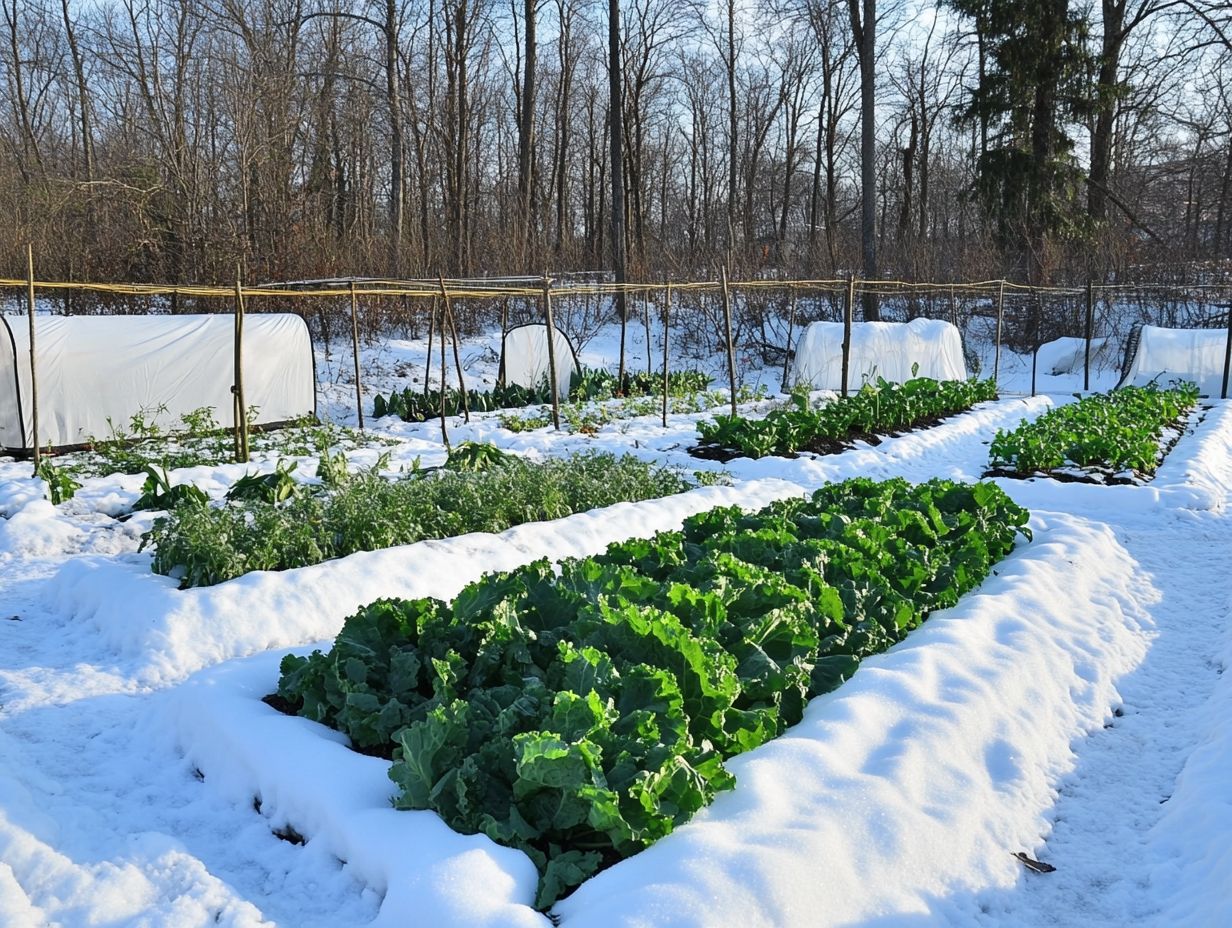
Winter gardening in cold climates allows for year-round access to fresh, homegrown produce. Additionally, you can explore the benefits of cold-climate gardening, which helps improve soil quality and overall plant health.
Can winter gardening in cold climates help save money?
Yes, winter gardening can save money by reducing the need to purchase produce from grocery stores. It also eliminates the cost of transporting produce from warmer climates.
What types of plants can be grown in a winter garden in a cold climate?
Leafy greens, root vegetables, and some herbs can be successfully grown in a winter garden in cold climates. These plants are hardy and can withstand freezing temperatures.
How does winter gardening benefit the environment in cold climates?
Winter gardening can benefit the environment by reducing carbon emissions associated with transporting produce from long distances. It also promotes biodiversity and supports local ecosystems.
What are some tips for successful winter gardening in cold climates?
Some tips for successful winter gardening in cold climates include choosing cold-hardy plants, using mulch to insulate the soil, and overcoming winter gardening challenges by providing adequate protection for plants during harsh weather conditions.
Are there any additional health benefits of winter gardening in cold climates?
Winter gardening in cold climates can also provide mental health benefits, as it allows for outdoor activities and exposure to sunlight during the colder months. Additionally, learning about the benefits of no-till gardening in cold climates can promote a healthier diet by providing access to fresh, nutrient-rich produce.
Ready to start your winter garden? Get started today!


